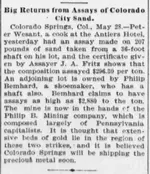Wow 130 ounces of gold per ton of
sand? My BS meter is screaming. Only a fool would buy into that "mine". Maybe that's what the story writer meant by "Pennsylvania capitalists".

Today the
richest gold mines in the area of Colorado Springs produce 0.028 ounces per ton (37+ tons mined per ounce of gold). The richest gold deposit ever in the United States and the second richest in the world the
Carlin Trend of Nevada produces at best 0.30 ounces per ton and on average about 0.20 ounces per ton. The best production ever from the second richest mine in the world was 1.03 ounces per ton.
The Summitville mine was the richest gold mine in Colorado history. It produced less than a quarter million ounces over 80 years at 1.2 ounces per ton in it's richest portions. Most ore produced less than 0.5 ounce per ton. It was not a free milling gold mine so was not in any way comparable to the fantastic and unbelievable 130 ounces per ton in the story presented in the OP.
Usually when a story seems to good to be true it probably isn't true. In the case of 130 ounce assays the best and most profitable strategy is to grab your wallet and RUN!

Thanks for sharing the story. These sorts of scams were a dime a dozen during the great mining era of 1850 - 1900. Even today
I see reports of these sort of rich finds. In all cases they are eventually exposed as scams. Gold is really rare stuff, that's part of the reason it's so valuable, finding it in the sort of quantity promoted in those old stories is an exciting concept but not a reality.
Heavy Pans






